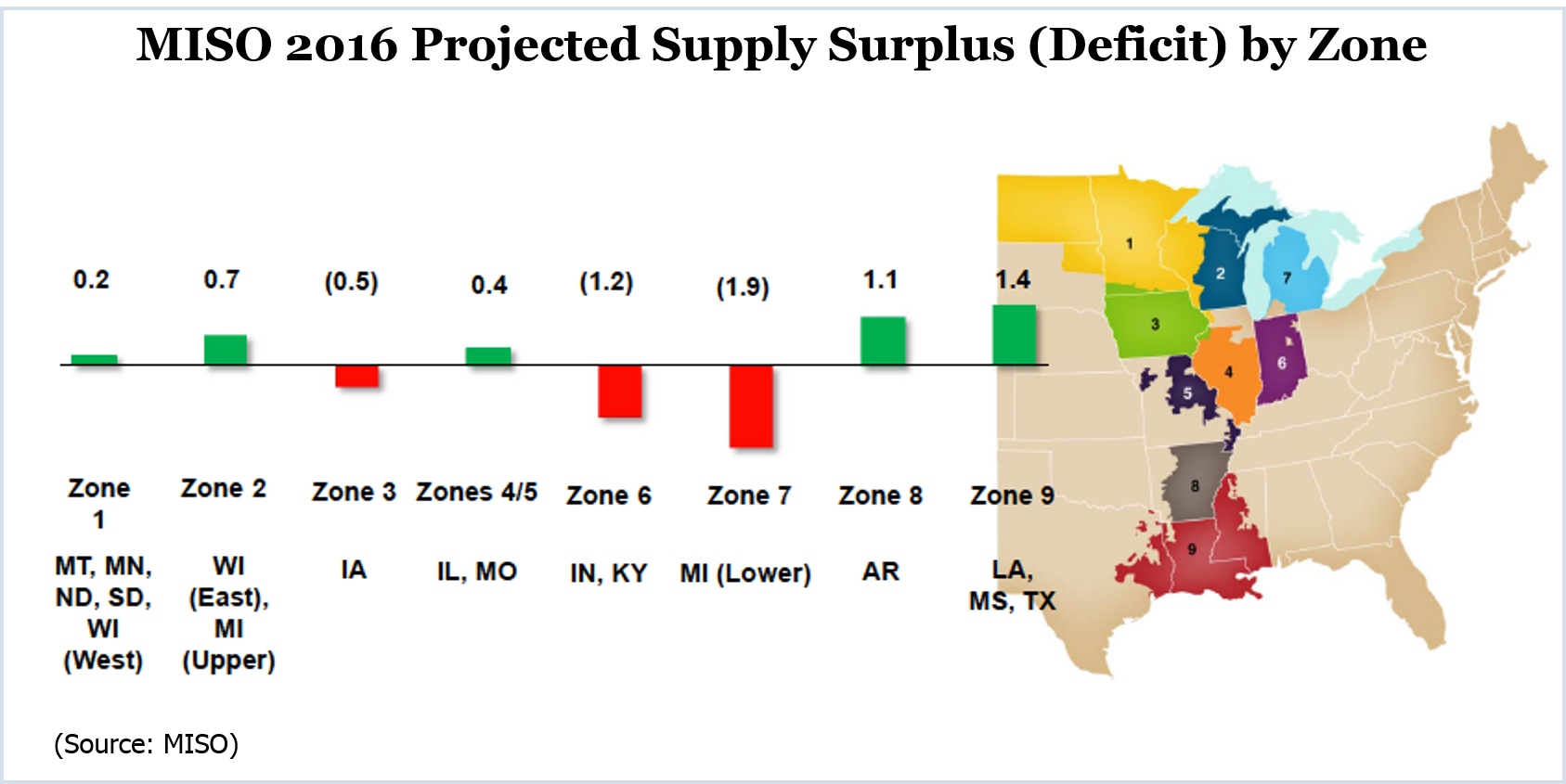By Chris O’Malley and Rich Heidorn Jr.

MISO told the Federal Energy Regulatory Commission last month that its Central and North regions expect a 2.3-GW shortfall in 2016, with three of the six zones failing to meet target reserve margins. While the recently integrated South region shows a 2.5-GW surplus over the same period, transmission constraints will limit the ability of the short zones to import the ISO’s spare megawatts.
“Reserve margins are tightening across the footprint, the result of aging infrastructure, environmental regulation, and decisions made by legislatures, utilities and regulators to diversify the generation fleet,” Eric Callisto, president of the Organization of MISO States (OMS) and a member of the Wisconsin Public Service Commission, told FERC. “The erosion of excess reserves understandably is of great concern to us all. And consistent with our relative roles in the industry, I believe there has been an appropriate response in the MISO footprint to this challenge.”
Some are skeptical of the forecasts, the result of a MISO survey of load-serving entities.
MISO officials had been warning last November that they faced a capacity shortfall of as much as 5 to 7 GW in 2016-17 due to the loss of coal-fired generation. In January, officials cut the forecast shortfall to 2 GW. In April, MISO told FERC it had reduced the projected shortfall further to 500 MW.
FERC Commissioner Philip Moeller noted that the projection assumed an increase in residential demand would be negated by a decline in industrial load. “If [industrial demand] turns around, as we hope it does, then your assumptions start getting shaken real quickly,” Moeller said.
Last Winter
Last winter was the coldest in two decades for many areas of MISO, with increased outages, record congestion and higher prices and uplift. Heating degree days rose 25% from the previous winter pushing average load was up 7%.
MISO set a new winter peak of 109.3 GW on Jan. 6, a 9% jump from the previous peak. The following day, MISO narrowly avoided having to shed load as it fell 1,900 MW short of operating reserves, leaving it with only 300 MW.
MISO’s Independent Market Monitor, Potomac Economics, said ISO operators were late to recognize the shortage and approved 700 MW in exports that began flowing at 7 a.m., 10 minutes before it fell into a shortage and 15 minutes before it declared a Maximum Generation Alert.
Prices
Day-ahead energy prices averaged $51.52/MWh for the winter, almost 80% higher than the previous year.
Fuel delivery problems and low storage levels led to extreme natural gas price volatility. Generating costs for gas units in the Midwest region were as much as 10 times that in the South, reflecting a disparity in gas costs. Natural gas prices at Chicago rose to $8.02/MMBtu, more than double the price a year earlier.
In late February, prices stayed above $10/MMBtu for 12 consecutive days. At the benchmark Henry Hub in Texas prices never rose above $8.
Midwest markets will have increased access to Marcellus and Utica gas by the end of 2014 with the addition of 425 MMcfd of pipeline capacity, FERC staff said in a presentation at the commission’s Oct. 16 meeting. As of Sept. 30, the price at Chicago was $3.93/MMBtu, up 5% from a year earlier.
Price volatility make whole payments, intended to encourage suppliers to follow dispatch instructions, rose steeply, with day-ahead payments rising four-fold to $40.3 million for the winter and real-time payments rising 57% to $3.2 million.
The cumulative outage rate was 9.5%, up from 7.3% in 2013/14 and 8.1% in 2012/13. Short-term forced outages, which the Monitor said can be an indicator of physical withholding, rose to 2.7% from 1.7%. The Monitor said it was investigating outages that contributed to shortages or severe congestion, as well as units that didn’t respond on Jan. 6 and 7.
Actions Taken
MISO spokeswoman Jennifer June Lay said the polar vortex “taught MISO and our member companies a number of lessons about how to maintain reliable operations as we face extreme cold weather.”
She highlighted several changes since last winter:
- Voluntary Load Management reporting was implemented in July to provide MISO more accurate data. “MISO lacked a clear understanding of demand response availability on a consistent basis due to the seasonal variation in potential and poor visibility into voluntary load management activities,” Lay said.
- A real-time display was added to the MISO control centers to show the status of the major pipelines in the MISO footprint. In addition, a gas pipeline notification page was added to the MISO website in August. It includes a list of critical pipeline notices impacting the MISO footprint with drill-down functionality to additional information, including a map of the affected pipelines and the generators they serve.
Lay said the ISO is also discussing potential initiatives to address fuel-supply issues for natural gas units, reduce outages and improve data collection on outages and derates.
MISO is also soliciting stakeholder feedback on a straw man proposal it presented in August to change the natural gas nomination schedule.

